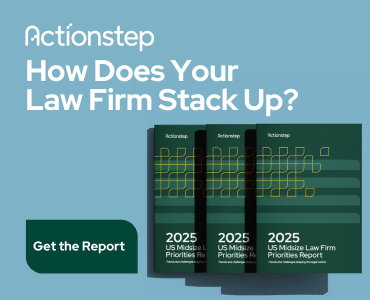Most law firms are sitting on a goldmine of messy, untrustworthy data. Which numbers can you trust? Here’s how to get to reliable law firm metrics.

Table of contents
As a CFO, I live in data. It’s the difference between confident, fast decision-making and that slow, nauseating spiral of indecision. And yet, even in 2025, most law firms are still struggling with one simple question: What’s our revenue?
Which Numbers Can You Trust?
It sounds basic. It should be basic. But ask around and you’ll get three different numbers. QuickBooks says one thing. The practice management system (PMS) says another. And then there’s that infamous spreadsheet that every law firm owner swears is the “real truth.”
And just like that, we’re down the rabbit hole. Which number is right? Why don’t they match? Can I trust any of this? If we can’t even agree on revenue, what else are we getting wrong?
That moment, when the numbers don’t line up, is the pivot point. Either you double down on fixing it or you continue living in data chaos, constantly second-guessing every decision.
Here’s the hard truth: If your data is not accurate, it’s not useful. And right now, most firms are sitting on a goldmine of messy, siloed, untrustworthy data.
The good news? This is fixable.
Law Firm Metrics: Why So Much Chaos?
First, let’s talk about where the chaos originates.
Terminology Chaos
Law firm data lives across systems: your CRM tracks leads, your PMS manages cases, QuickBooks handles your financials, and maybe you’ve layered in tools like CallRail or a VOIP phone system for communication tracking. Each system speaks its own language. None of them syncs by default.
So when you try to make sense of it all, it’s like translating five dialects at once. And if your systems aren’t integrated, you’re not making strategic decisions — you’re firefighting.
The foundation of clean, useful data is integration. But integration isn’t just a technical job. It starts with language and logic. If your CRM labels a new lead as an “opportunity” and your PMS calls it a “potential new client,” you’re already in trouble.
First Step: Consistent Terms
You need consistent terms across all systems. One name. One meaning. Everywhere.
This sounds tedious, but it’s not optional. Think of it like legal drafting. Words matter.
Ambiguity kills clarity.
Second Step: Process Mapping
Once you align terminology, the next step is process mapping. Literally trace what happens to a piece of data as it moves through your firm. A new lead comes in. Then what? It’s assigned, followed up, converted, onboarded, billed, closed out. Where does that data go? Who touches it? Where does it break?
Mapping your process isn’t just about optimization. It’s about visibility. You can’t fix what you can’t see.
Finally, A Single Source of Truth
After that, it’s time to build a single source of truth. That’s not a metaphor. It’s a dashboard.
A Real, Visual, Automated Dashboard
Tools like Power BI and Domo were built for this exact problem: to pull live data from multiple systems, reconcile the differences, and present it in a format that helps you make informed decisions.
Forget spreadsheets full of numbers. You need color-coded indicators. Green means go. Yellow means dig in. Red means act now.
Here’s what that dashboard should include:
- One or two numbers that monitor your leads and marketing effectiveness. Maybe “audience reach” and “initial contacts.”
- A couple of key numbers that assess sales effectiveness. “Conversion rate” is a good one. Additionally, you may want to track “new cases,” “cases signed,” or the “average new case value” if you use flat fees.
- Now you want to look at your people. Are they being productive? If you bill hourly, you definitely want to track “WIP” (hours worked); flat fee firms might use something like “petitions filed” or “applications submitted.” For contingency firms, we love using “percent of cases” within tolerance. This means what percentage of cases are moving on schedule, and which ones are stuck?
- Include something that helps you understand the firm’s “capacity.” How many cases do you have? Do you have too many, too few, or just +-the right number of people work on them? And how long will that last?
- We can’t forget about the clients. Are they happy? I’m told all the time that this can’t be measured, but it can. I have one client whose paralegal sneaks in a survey question or two in every interaction, so they always have data.
- And finally, you have to track at least a few numbers related to money.
Track momentum and motion
When setting up your dashboard, make sure you are able to see 13 rolling weeks of history at a time. Why 13 weeks? Because trends don’t reveal themselves in snapshots. You need to see momentum, not just motion.
The key here is automation. If someone is manually updating a spreadsheet every week, your data isn’t accurate, and it’s vulnerable. You need daily (or hourly) syncs. Let the software do the work. Your team should be interpreting data, not cleaning it. That’s where mistakes happen.
For more specifics, read Brooke’s article, “What Should Be on Your Law Firm’s Dashboard.”
Make Your Law Firm Data Sacred Again
Of course, none of this matters if no one trusts the numbers. During rollout, run your dashboards alongside your old, existing reports. Find the mismatches. Track them down. Build confidence by showing your work. And make sure there’s an audit trail. Data integrity requires accountability.
Tip: When sharing access to data, keep it role-specific. Your intake team doesn’t need billing details. Most attorneys in the firm don’t need marketing metrics. Customize views by role. That keeps it focused and keeps sensitive info where it belongs.
At the end of the day, a CFO’s job is to create decision clarity. Clean, integrated data is the foundation of that clarity. It allows a firm to operate with speed and precision. No more slow, anxious decisions. No more flying blind.
As a law firm owner, you don’t need more reports. You need better ones. And those start with one clean set of numbers that everyone believes.

Attorneys work tirelessly to build their practices and are beginning to realize that these businesses have value.
In Exit On Top, financial advisor Brooke Lively addresses the practical aspects of creating an easy-to-sell law firm, providing the roadmap and tools that will allow you to… exit on top. Learn more at www.ExitOnTopBook.com.
More Profitable Law Firm Tips from Brooke Lively
For more tips on building a more profitable law firm, read:
- Are Your Law Firm’s Financial Systems Ready to Scale?
- The Path to Partnership: Embracing the ‘P’ Word Is the Key to Law Firm Growth
- Law Firm Profits and Year-End Taxes: Avoiding a Surprise Tax Bill
- 5 Ways You May Be Sabotaging Your Firm’s Growth
- The Best Compensation Plans Use the Law of Thirds
- Law Firm Overhead: What It Is — and What It Isn’t
- Building a Law Firm That Pays You First
- Understanding Law Firm Profits — And What to Do With Them
- How Are Law Firm Owners Paid? Total Compensation vs. Salary
- Funding Growth: Are You Starving Your Law Firm?
Image © iStockPhoto.com.

Sign up for Attorney at Work’s daily practice tips newsletter here and subscribe to our podcast, Attorney at Work Today.
















